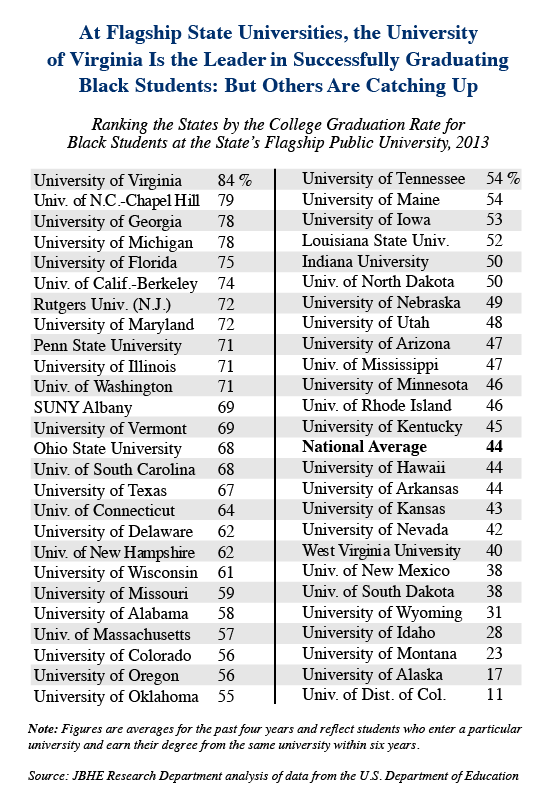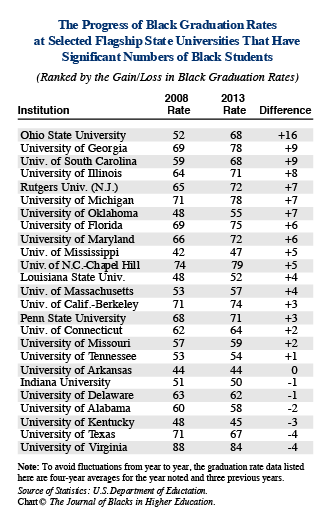 Much of the editorial in JBHE deals with the progress of Black students at the nation’s highest-ranked colleges and universities. But it is always important to keep in mind that large state-operated universities enroll as much as 75 percent of all African-Americans who are participating in higher education in this country. Tens of thousands of Black students are enrolled at the nation’s flagship state universities, generally the premier public institutions in a given state.
Much of the editorial in JBHE deals with the progress of Black students at the nation’s highest-ranked colleges and universities. But it is always important to keep in mind that large state-operated universities enroll as much as 75 percent of all African-Americans who are participating in higher education in this country. Tens of thousands of Black students are enrolled at the nation’s flagship state universities, generally the premier public institutions in a given state.
Every year since JBHE has tracked graduation rates for Black students, the University of Virginia has had the highest graduation rate for African Americans among the flagship institutions. This year is no exception. The Black student graduation rate of 84 percent at the University of Virginia is the highest of any of the nation’s flagship state universities. The University of North Carolina at Chapel Hill is second, with a Black student graduation rate of 79 percent. The University of Georgia and the University of Michigan have a Black student graduation rate of 78 percent.


Other flagship state universities with a Black student graduation rate at or above 70 percent are the University of Florida, the University of Washington, Penn State, Rutgers University, the University of Illinois, the University of Maryland, and the University of California at Berkeley. All told, there are 11 flagship state universities with Black student graduation rates above 70 percent, nearly triple the number from five years ago.
If we look at only those universities where Black students make up a significant percentage of the undergraduate student body, we find that the biggest improvement in Black student graduation rates over the past five years has been at Ohio State. There the Black student graduation rate has improved from 52 percent to 68 percent. At the University of Georgia and the University of South Carolina, the Black student graduation rate is up 9 percentage points from five years ago. The University of Illinois has shown an eight percentage point improvement and the Black student graduation rate is up seven percentage points at Rutgers University, the University of Michigan, and the University of Oklahoma.
Overall, at the 25 flagship state universities with significant percentages of Black students, the Black graduation rate is up at 18 institutions over the past five years and down at only six institutions. The rate stayed the same at the University of Arkansas. This is impressive progress.
The University of Texas and the University of Virginia showed the largest declines of four percentage points. But despite the decline, the University of Virginia remains in first place among all flagship state universities with the highest Black student graduation rate. The bottom line is that several other flagships are getting much closer to catching up with the University of Virginia.
It should be noted that the College of William and Mary, another state-operated educational institution in Virginia, also has a Black student graduation rate of 84 percent. This is identical to the rate at the flagship University of Virginia.


JBHE: Have you been tracking the College of William and Mary’s Black graduation rate since the beginning of your project? Since no date was given to when you(JBHE)began tracking the Black student graduation rates, how does the William and Mary Black student graduation rate compare to the University of Virginia for each year that you conducted the tracking?
The University of Virginia has also seen a steep significant decline in the overall Black student population which needs to be addressed soon in a comprehensive manner by the entire hierarchy and Board of Visitors at the University.
When we first started tracking graduation rates we included only national universities ranked in the top 25 by U.S. News & World Report and we also looked flagship state universities. The University of Virginia was included but not the College of William and Mary. So we don’t have the year to year comparison you seek. We do know that in recent years the Black student graduation rate has been very close or surpassed the rate at the University of Virginia.